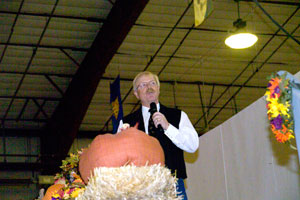Vaccination: What the Heck Am I Doing?
by Troy Smith for Angus Productions Inc.
MITCHELL, Neb. (Dec. 1, 2011) — On the final day of Range Beef Cow Symposium XXII, veterinarian G.L. "Jerry" Stokka spoke out in defense of technologies used to enhance food production. A former extension veterinarian now with Pfizer Animal Health, Stokka said technology is too often portrayed in an unfavorable light.

G.L. "Jerry" Stokka“Technology is not a dirty word. It is not evil,” stated Stokka. “The prudent use of technology is part of good stewardship.”
Stokka said vaccines represent a valuable technology, but their use can be confusing. There are hundreds of different vaccines available, with multiple antigens and differing levels of effectiveness and safety. Veterinarians, said Stokka, serve a critical role in making recommendations based on individual herd objectives and assessment of risk for disease exposure and economic loss.
“There are three questions to consider when deciding whether vaccination is appropriate,” emphasized Stokka. “Is it necessary? Is it effective? And is it safe to use?”
Likening vaccines to insurance, Stokka said vaccination is necessary when there is a reasonable expectation of exposure to disease and a resulting economic loss. Then it must decided whether there is product capable of providing an acceptable level of protection. Finally, it must decided whether the product is safe for all classes and ages of cattle, without excessive tissue or systemic reaction.
Stokka also emphasized the need to handle and administer vaccines properly. Exposure to extreme temperatures or direct sunlight will reduce efficacy. Mixing reconstituted vaccines incorrectly or shaking them violently may also have negative impacts.
“Injection does not equate with vaccination,” stated Stokka, emphasizing that proper dosage and placement of vaccines are important.
“And vaccination does not equate with immunization,” he added, explaining how the animal’s body must recognize that a vaccine has been introduced, activate the immune system and then initiate an immune response. Consequently, immunity is not immediate. It takes time.
Stokka advised producers to consult their veterinarians regarding types, timing and handling of vaccines.
To see the PowerPoint that accompanied Stokka's presentation, click here.
The biennial Range Beef Cow Symposium was hosted Nov. 29-Dec. 1 at the Mitchell Events Center, Mitchell, Neb., by the cooperative extension and animal science departments of the University of Nebraska-Lincoln, South Dakota State University, Colorado State University and the University of Wyoming. Comprehensive coverage of the event is provided online at www.rangebeefcow.com, an event coverage site provided by Angus Productions Inc. (API), publisher of the Angus Journal and the Angus Beef Bulletin.
Editor’s Note: API's coverage of the event is made available for distribution to all media via an agreement with the Range Beef Cow Symposium Committee and API. Headquartered in Saint Joseph, Mo., API publishes the Angus Journal, the Angus Beef Bulletin, the Angus Beef Bulletin EXTRA, and the Angus e-List, as well as providing online coverage of events and topics pertinent to cattlemen through the API Virtual Library. For questions about this site, or to notifiy us of broken links, click here.


